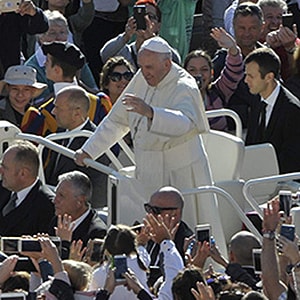‘An uninterrupted path of unity’ since 1964 meeting of Paul VI, Athenagoras
By Patriarch Pierbattista Pizzaballa*
The joy that the pilgrimage of Pope Paul VI brought sixty years ago to the life of the city of Jerusalem, and the newness it sparked, remains a part of the current life of Christians in the Holy Land.
Indeed, as always, and as with everything concerning Jerusalem, the profound meaning of those events, and in particular the meeting between the Holy Father and the Ecumenical Patriarch Athenagoras, changed the face of the Church and marked its path to this day.
The Bishop of Rome returned to Jerusalem, from where he had set out two thousand years ago. In the pilgrimage that took him to the main holy places, he encountered the wounds that history had left visibly in the geography of the places and the people of that time and today.
But he also gathered the strong and powerful embrace of the entire population, who welcomed him with incredible joy and enthusiasm, and who showed their pastors, unmistakably, the desire not to remain prisoners of the difficult history of this Land, but to go beyond.
The films of the time show Paul VI entering the Holy City, almost crushed by the enthusiastic and euphoric crowd. Sometimes, indeed, small gestures that, perhaps unknowingly, were eagerly sought by many, are enough to release the desire for encounter and peace that smolders in the heart of every person, especially here in the Holy Land, which is marked by eternal tensions, conflicts, and divisions.
Christian Jerusalem was frozen—almost suspended—between ancient laws and regulations that seemed to paralyze, rather than regulate, communal life.
Pope Paul VI's visit had the merit of breaking that wall, which then seemed very solid, of the various status quos, often used more wrongly than rightly, to avoid dealing with one another. That simple visit was enough to sweep away centuries of dust on our relations.
The meeting with the Ecumenical Patriarch of Constantinople was undoubtedly the event that marked that pilgrimage.
The return of Peter after two thousand years to Jerusalem, the birthplace of the one and indivisible Church, could not overlook that wound, the deepest of all, that has marked the course of the Church for an entire millennium. And indeed, Peter's return to Jerusalem was also the beginning of a new journey, for all Christians, of rapprochement, re-reading, and redemption of their respective histories, of the desire and nostalgia for lost unity.
After all, to return and depart from Jerusalem always and necessarily brings a profound change. For a Christian, Jerusalem is the place that gave concreteness to Redemption, that changed the meaning of forgiveness, justice, truth. One cannot come to Jerusalem without coming to terms with these realities, which here, I repeat, acquire a unique concreteness.
Since then, much has changed in ecumenical dialogue. Today, we take for granted attitudes of respect and friendship between the Churches. We owe this to them, to the Pope and the Ecumenical Patriarch, and to their courage and their vision.
Pope Francis, with his pilgrimage of prayer in the Holy Land in 2014, and with the renewed meeting with the Ecumenical Patriarch, Bartholomew, has concretely shown how far the Church has come in those fifty years and thereafter.
In 1964, the meeting was held on the Mount of Olives, a significant place, but also peripheral to the city of Jerusalem.
In 2014, on the other hand, it took place in the heart of Christian Jerusalem, the Holy Sepulchre, which is not only the place that commemorates the death and resurrection of Christ but is also the Place that, rightly or wrongly, is considered the symbol of our divisions.
Certainly, we who live in Jerusalem know well how long the journey yet remains, and how difficult it is sometimes to stay and live together, but the simple fact that such an important event can be held in our most beloved place is an unequivocal sign of the journey made to this day.
Sixty years ago that embrace broke down the wall of division between the two Churches, inaugurating a new era for the life of the Church. The embrace held fifty years later renewed the momentum of joy and unity in the Spirit that none of us can now predict, but which is already bearing abundant fruit for the life of the Church today.
We see this in the restorations of the Basilica, which are done together, a fact today taken for granted but unthinkable until a few years ago. The meetings, declarations, and joint initiatives between the Churches today are considered ordinary matters. The joint pastoral initiatives, in schools and parishes, are expressions of a desire for fraternity that is not just of a few but of the entire local Christian community, in its different denominations. The Pastoral Vademecum of the Catholic Church, which gives concrete indications on how to celebrate the sacraments for mixed families (which are the vast majority), respecting the sensibility of all, is another example.
Even today, perhaps more than before, we need courageous men and women, capable of vision, of being able to see beyond the present pain, to free our hearts oppressed by too many fears, and who, like Paul VI and Athenagoras, with their words and their gestures, know how to show the Christians of the Holy Land today the difficult and fascinating way of peace.
* Cardinal Patriarch of Jerusalem of the Latins
Thank you for reading our article. You can keep up-to-date by subscribing to our daily newsletter. Just click here









